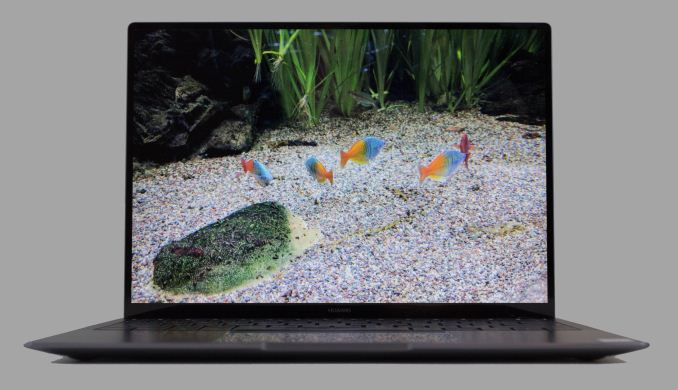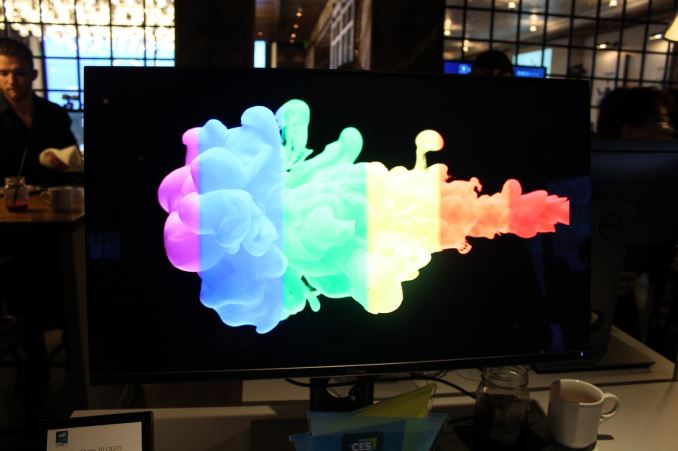AT 101: Understanding Laptop Displays & How We Test Them
by Brett Howse on July 10, 2018 8:00 AM ESTFinal Words
Don’t think of this as an in-depth look at any of these topics. Each on its own could arguably require a full-length article, or more. Color management is a field unto itself, and we’ve only touched on the tip of the iceberg.
The display on a laptop is arguably the most important aspect, since it’s the one thing you will always be using. Other factors can be as important, such as the keyboard, battery life, and build quality, depending on application, but the display can make or break the experience.
Luckily the bar for display quality has gone up significantly in recent years. It’s difficult, but not impossible, to find a premium or business laptop without an IPS display now, and that alone has increased the usability of laptops considerably. Some gaming laptops may still offer TN displays with ultra-high refresh rates for the ultimate in gaming smoothness, but those same devices will generally be offered with a lower refresh rate IPS panel as an option as well. TN still has its advantages, but for most computing needs, IPS wins out.

The Huawei MateBook X Pro features a 3000x2000 LTPS IPS Display
OLED still has some work needed before it will be a mainstream option in the laptop market. The main one is battery life. In our review of the Lenovo ThinkPad X1 Yoga we were able to test both the LCD model and the OLED model. The OLED version achieved only 59% of the battery life of the LCD version, which worked out to about 2.5 hours less. The OLED power problems are exacerbated by the amount of content on a PC which is white, such as most web browsing, word documents, spreadsheets, and more. This is the worst case scenario for OLED, and though some websites have dark modes, the majority do not. Windows does support a dark mode, but for most content it’s simply some chrome around the edges.With OLED there’s also issues with ghosting and burn-in which can be a problem on the PC because so much content like the taskbar is static.
Dell's 30-inch OLED monitor shown at CES
We’ve also seen some nice strides in terms of efficiency upgrades on LCD panels, especially with high-resolution (high-density) displays, thanks to new materials being used to construct the underlying thin-film transistors. It’s likely that a lot of effort is being spent here by display manufacturers to continue to improve this. High resolution used to be a liability in terms of battery life, but laptops like the Huawei MateBook X Pro offer exceptional battery life and efficiency despite the 3000x2000 resolution, likely in a large part due to the LTPS TFT they are using. The MateBook X Pro is as efficient as the ASUS ZenBook 3 with the same CPU and only a 1920x1080 display.
We’re still at a point where Windows expects you to be using the sRGB color space, and displays – especially laptops without proper 3D LUTs that can be set to different gamuts – can be problematic. Some Adobe RGB-capable laptops like the Dell XPS 15 do have the ability to change the gamut in hardware though, so you can set it to Adobe RGB when working on photography, and then back to sRGB for the rest of the time. The lack of a proper color management system at the OS level in Windows means that if you don’t do this, colors will be blown out all across the system, from the wallpaper to the web browser. Microsoft has added a lot more functionality on transforms with their HDR stack though, so perhaps this will be solved eventually. This is one advantage Apple has held for a long time.
 Blown out colors on the Photos App vs Photoshop Elements
Blown out colors on the Photos App vs Photoshop Elements
Finally, we went over how we test and why. Testing a display objectively is the only method we have available for an apples to apples comparison. Some people may prefer the colors to be a bit oversaturated, but they aren’t seeing the true image that they should. Once you’ve used an accurate display, it’s difficult to go back, and having a display calibrated at the factory is always the way to go. If Apple can afford to do it on a $399 iPad, certainly a laptop manufacturer can find it in their budget to calibrate a $2000 Ultrabook.
There’s a lot to look forward to with displays as well. High resolution is already here, but HDR and wider color spaces are going to change the game over the next couple of years. There’s no way to stop the march of technology.











49 Comments
View All Comments
s.yu - Saturday, July 21, 2018 - link
So...no mention about what non-PWM screens use for dimming? Or do high frequency PWM screens don't count as PWM? And a lot of people seem to be complaining in particular PWM of OLED screens, so why do OLED screens (at least the RGB variety) all use low frequency controllers?Solandri - Saturday, July 28, 2018 - link
Very nice article. Some minor corrections/additions. (I'll post one at a time since the site is flagging it as spam)Light from our sun is actually about 5800K. 6500K is the combination of sunlight and blue sky on a sunny day. It's bluer than direct sunlight because part of the red light gets scattered by the atmosphere (and sent to regions experiencing sunrise/sunset). Daylight in the shade (lit mainly by the blue sky) is closer to 9000K. That combined with the 5800K direct sunlight produces about 6500K.
Solandri - Saturday, July 28, 2018 - link
Non-RGB subpixel arrangements can offer the same viewing experience as RGB while using fewer pixels. Your eyes have the best resolution in green, not so good in red, and absolutely terrible in blue. The non-RGB subpixel layouts take advantage of this, usually by using two green subpixels for each red and blue subpixel. This results in fewer total subpixels (a "lower" resolution), but no discernible loss of resolution to your eye. Older video standards like NTSC and even newer image encoding algorithms like JPEG and MPEG do the same thing to reduce storage space by decreasing the color resolution. So this isn't something new - every TV show you've viewed growing up had its colors mangled this way, and you've never noticed it. So it's silly to suddenly pretend that non-RGB is suddenly inferior.Solandri - Saturday, July 28, 2018 - link
Ah, it was the website link for this which was flagging the comment as spam. Google "your eyes suck at blue" and you'll get the site with a graphical example of how you can completely mangle the blue channel and the picture will still look the same.Solandri - Saturday, July 28, 2018 - link
The oddball RGB subpixel layout often used in OLED panels can actually be better for devices which are meant to be used in both portrait and landscape orientation. The RGB subpixels are usually arranged so the relative position of red, green, and blue are the same when rotated 90 degrees (though there might be a shift of one subpixel). In contrast, the traditional RGB stripe layout is completely different when rotated 90 degrees.Keeping the subpixel layout the same in both orientations allows you to do subpixel rendering in both orientations. Subpiexl rendering improves the apparent resolution of the screen without increasing the actual resolution. So if you're rendering a diagonal white line, instead of rendering it as (capital letters are lit, lowercase are black):
rgbRGB
rgbRGB
RGBrgb
RGBrgb
You render it as
rgbRGB
rgBRGb
rGBRgb
RGBrgb
And you've tripled the screen's apparent resolution without adding any new pixels. This trick is most often used with fonts (ClearType in Windows). But the RGB subpixel layout means apparent resolution can only be increased in one direction, and fonts designed for subpixel rendering will only work in one screen orientation. If you rotate the screen 90 degrees, suddenly the subpixels don't fall the way you expect, and your subpixel rendering breaks. Not so with the subpixel layout used in some OLED screens. If you turn the screen 90 degrees, the RGB layout remains the same, and your subpixel rendering still works.
Solandri - Saturday, July 28, 2018 - link
You forgot to mention the RGBW subpixel layout, which I wish would die but keeps coming back. That's where they add a white subpixel to increase the apparent brightness of the screen. The R, G, and B subpixels generate those colors by blocking 66% of the light. So when you display a white pixel (R, G, and B lit), you're actually only seeing 33% of the backlight brightness. Someone came up with the idea of adding a white subpixel, so when displaying white you see 3*(33%*25%)+(100%*25%) = 50% of the backlight brightness. So the screen can appear brighter at the same power level, or the laptop will use less power at the same image brightness.Unfortunately this comes at the cost of muting colors, since your colors are now only transmitted through 75% of the subpixels instead of 100%. And you end up with pale red, green, blue, and mustard yellows and lavender purples.
Solandri - Saturday, July 28, 2018 - link
The solution many vendors came up with to customers complaining about poor colors is to create a mode where the white subpixel is always off. But if you do that, now your whites are generated by only letting 3*(33%*25%)+(100%*0%) = 25% of the backlight through. And now your screen will either be dimmer than RGB, or will use more power when at the same brightness as RGB. In other words, you've defeated the purpose of using RGBW subpixels in the first place. If you see a review mention the screen is RGBW, that's a big red flag and should be avoided.HappyTechKnow - Tuesday, July 31, 2018 - link
2. ASUS ZenBook Flip 14 UX461UA-DS51T
best laptopsbest laptops
Asus Zenbook series originated as thin and light. UX310UA kept the proud heritage, featuring a timely elegant all-new design with a profile which is only 0.5-inch thickness. It took many manufacturing steps to architect the design into a sleek shape. Solid aluminum alloy has been used to keep the weight down to1.4 kg. Superb 8th generation Intel core up to i7 processor with 8GB LPDDR3 2133MHz RAMfor smooth video to be run.
14-Inch wide-view Full-HD nano-edge bezel touch display in 13.3” chassis with Stylus pen and Windows 10 Pre-installed display will give your eyes a soothing treat whether you are viewing photos, reading a text and video editing much easier than you can imagine.
An ultra-storage capacity of 256GB SATA SSD and the built-in fingerprint reader with one-touch login via Windows Hello feature A full size backlit keyboard is constructed for an outstanding experience. This best budget laptop is surely going to value your money by providing you the best.
https://happytechknow.com/2018/07/03/best-laptop-a...
rannyjohns - Monday, November 5, 2018 - link
Best work you have done, this online website is cool with great facts and looks. I have stopped at this blog after viewing the excellent content. I will be back for more qualitative work, here some like you https://tinyurl.com/y8f94w2l